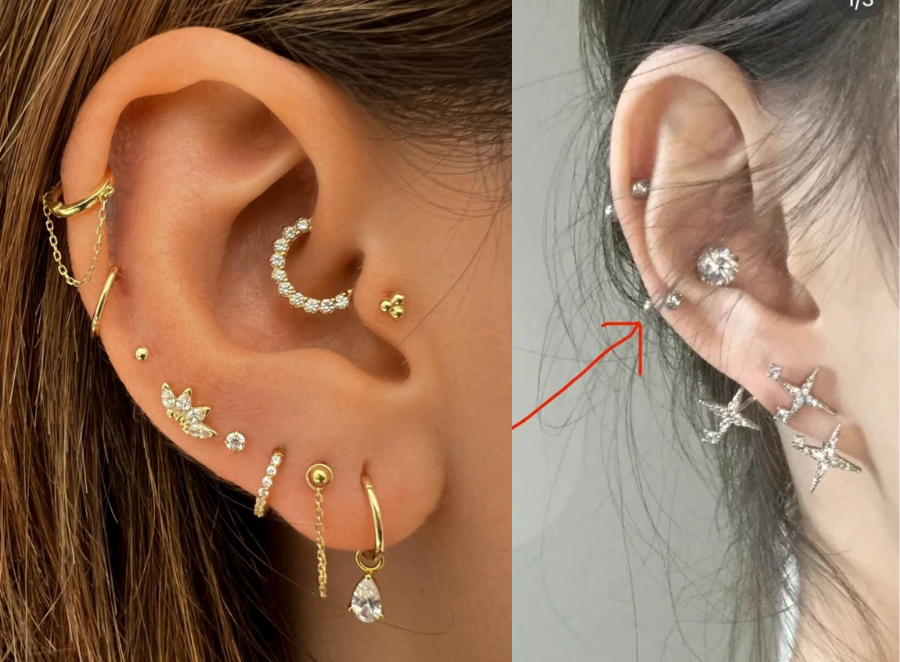Helix piercing has become a beloved choice for those looking to express their style through body art. This comprehensive guide covers everything you need to know about helix piercing, including its variations, the procedure, aftercare, and styling tips. Whether you’re new to piercings or an experienced enthusiast, this article will help you navigate your journey.
Defining Helix Piercing
A helix piercing is a type of body modification located on the upper cartilage of the ear. This piercing is popular for its aesthetic appeal and versatility, allowing for various jewelry styles that can complement any look. Its unique position gives it a distinctive flair, making it a favored choice among many.
Different Styles of Helix Piercings
There are several styles of helix piercing, each offering a unique aesthetic:
- Single Helix: The most basic form, featuring one hole in the upper cartilage.
- Double Helix: Two piercings positioned closely together, creating a stacked appearance.
- Triple Helix: Three piercings in a row, ideal for a dramatic effect.
- Forward Helix: Located at the front of the upper cartilage, adding an interesting twist.
- Industrial Piercing: A combination of two piercings connected by a single barbell, creating an edgy look.
Choosing the right style will depend on your personal preference and how you envision your ear jewelry.
The Helix Piercing Procedure
Understanding the helix piercing process can help alleviate any fears. Here’s a step-by-step overview of what to expect:
- Consultation: You’ll have a discussion with a professional piercer to determine placement and jewelry options.
- Preparation: The piercer will clean your ear and mark the exact spot for the piercing.
- The Piercing: A sterilized needle will be used to create a precise hole in the cartilage.
- Jewelry Insertion: High-quality jewelry will be immediately placed to minimize discomfort and irritation.
Pain and Sensitivity
Many prospective clients worry about the pain associated with helix piercing. The sensation is usually a quick, sharp pinch followed by a dull ache, and pain levels can vary among individuals. Generally, because the piercing is in cartilage rather than flesh, many find it more tolerable than other types of piercings.
After the initial discomfort, some swelling may occur, but this typically subsides within a few hours. If you experience persistent pain, consult your piercer.
Aftercare for Helix Piercing
Proper aftercare is crucial for ensuring your helix piercing heals correctly. Follow these essential tips:
- Cleaning: Use a saline solution or specialized aftercare spray twice a day to clean your piercing.
- Hands Off: Avoid touching the piercing to prevent introducing bacteria.
- Jewelry Maintenance: Do not change the jewelry until your piercing has fully healed, which can take several months.
- Avoid Water Exposure: Stay away from swimming pools and hot tubs during the healing process to minimize infection risk.
Signs of Infection
Being vigilant about potential infections after a helix piercing is important. Look out for symptoms such as:
- Increased redness or swelling
- Unusual discharge, especially yellow or green
- Persistent pain or throbbing
- Fever or chills
If you notice any of these signs, contact a healthcare professional immediately.
Choosing Jewelry for Your Helix Piercing
Selecting the right jewelry is key to both comfort and style for your helix piercing. Here are popular options:
- Hoops: Trendy and versatile, available in various sizes and designs.
- Studs: Simple and classic, perfect for a polished look.
- Barbells: Great for more intricate piercings like industrial styles.
Always choose hypoallergenic materials, such as titanium or surgical stainless steel, to minimize irritation and allergic reactions.
Creative Ways to Style Your Helix Piercing
A helix piercing provides a canvas for creativity. Here are some styling ideas:
- Layering Jewelry: Mix and match different types of jewelry for a personalized touch.
- Color and Design: Opt for pieces that showcase your personality through colors and unique designs.
- Asymmetrical Arrangements: Embrace an asymmetrical look with varied jewelry styles for a contemporary vibe.
Understanding the Cost
The cost of a helix piercing can vary significantly based on the piercer’s expertise and location. Generally, you can expect to pay between $30 and $100 for the procedure, with additional jewelry costs ranging from $20 to over $100.
Finding a Skilled Piercer
Choosing a qualified piercer is essential for a successful helix piercing experience. Here are tips for selecting the right professional:
- Research Reviews: Look for studios with positive customer feedback and a solid reputation.
- Verify Credentials: Ensure that your piercer is certified and adheres to health and safety standards.
- Inquire About Experience: Don’t hesitate to ask about their background and approach to aftercare.
The Cultural Importance of Helix Piercing
Helix piercing carries cultural significance in various traditions. In many cultures, ear piercings symbolize milestones and personal expression. Learning about these meanings can enhance your appreciation for your own helix piercing.
Debunking Common Myths
There are several myths surrounding helix piercing that can create confusion:
- It’s Excruciatingly Painful: Most individuals find the pain manageable and brief.
- Infections Are Inevitable: While infections can happen, they are often preventable with proper care.
- You Can’t Sleep on It: Many people successfully find comfortable sleeping positions even with new piercings.
Final Thoughts
A helix piercing is an exciting way to enhance your body art collection. By understanding the procedure, aftercare, and styling options, you can confidently enjoy your piercing. Make sure to choose a skilled piercer and adhere to aftercare practices to ensure a positive experience with your helix piercing.


